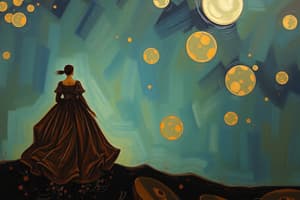Podcast
Questions and Answers
Which adult structure is formed from the prosencephalon?
Which adult structure is formed from the prosencephalon?
- Medulla oblongata
- Cerebrum (correct)
- Cerebellum
- Pons
What structure develops from the basal plates during spinal cord development?
What structure develops from the basal plates during spinal cord development?
- Posterior horn
- Anterior horn (correct)
- Dorsal root ganglion
- Alar plates
Which event occurs first during the development of the spinal cord?
Which event occurs first during the development of the spinal cord?
- Differentiation of neuroprogenitors into neuroblasts
- Development of the central canal
- Closure of rostral and caudal neuropores (correct)
- Formation of the dorsal root
How do sulci and gyri typically develop?
How do sulci and gyri typically develop?
Which structure is formed from the metencephalon?
Which structure is formed from the metencephalon?
Which structure is associated with sensory neuron cell bodies during the development of the spinal cord?
Which structure is associated with sensory neuron cell bodies during the development of the spinal cord?
Which of the following is NOT a part of the diencephalon?
Which of the following is NOT a part of the diencephalon?
What function do the alar plates serve in spinal cord development?
What function do the alar plates serve in spinal cord development?
What primarily differentiates the gray matter in the CNS?
What primarily differentiates the gray matter in the CNS?
Which of the following is NOT a component of a nerve?
Which of the following is NOT a component of a nerve?
Which of the following correctly describes the neural tube's role in CNS development?
Which of the following correctly describes the neural tube's role in CNS development?
What does the neural crest give rise to?
What does the neural crest give rise to?
During which week of development does neurulation begin?
During which week of development does neurulation begin?
The structure that primarily forms the ventricles and central canal is the:
The structure that primarily forms the ventricles and central canal is the:
What distinguishes the alar plate from the basal plate in CNS development?
What distinguishes the alar plate from the basal plate in CNS development?
What is primarily found in the gray matter of the cerebellum?
What is primarily found in the gray matter of the cerebellum?
Study Notes
CNS Histology
- Cerebrum: Gray matter contains neurons, white matter contains myelinated axons
- Cerebellum: Gray matter contains neurons, white matter contains myelinated axons
- Spinal Cord: Gray matter contains neurons, white matter contains myelinated axons
- Ganglion: Contains neurons, axons, myelin sheath
- Nerves: Contains axons (nerve fibers) and myelin sheath
- Nerve Fascicle: Contains bundles of axons (nerve fibers)
- Epineurium: Outermost layer of connective tissue around nerve
- Perineurium: Connective tissue sheath surrounding individual nerve fascicles
- Endoneurium: Layer of connective tissue surrounding each axon within a fascicle
CNS Development
- Week 3:
- Neurulation begins
- Neuroplate forms
- Neural tube forms
- Week 5:
- Three brain vesicles formed:
- Prosencephalon: Forms the forebrain
- Mesencephalon: Forms the midbrain
- Rhombencephalon: Forms the hindbrain
- Three brain vesicles formed:
- Adult brain:
- Prosencephalon:
- Telencephalon: Forms the cerebrum and lateral ventricles
- Diencephalon: Forms the thalamus, hypothalamus, epithalamus, and third ventricle
- Mesencephalon: Forms the midbrain and cerebral aqueduct
- Rhombencephalon:
- Metencephalon: Forms the pons and cerebellum
- Myelencephalon: Forms the medulla oblongata and fourth ventricle
- Prosencephalon:
- Sulci and gyri develop late in fetal development, formed at birth
- Spinal cord:
- Alar plate: Forms the posterior horn, contains sensory neuron cell bodies of dorsal root ganglia
- Basal plate: Forms the anterior horn, contains motor neuron cell bodies
- Neural canal becomes central canal
Studying That Suits You
Use AI to generate personalized quizzes and flashcards to suit your learning preferences.
Related Documents
Description
Test your knowledge on the histology and development of the central nervous system (CNS). This quiz covers essential aspects such as the structure of the cerebrum, cerebellum, spinal cord, and the stages of CNS development during crucial weeks. Perfect for students studying neuroanatomy and developmental biology.




